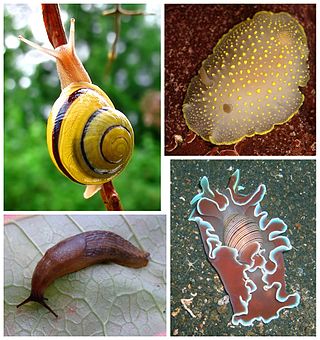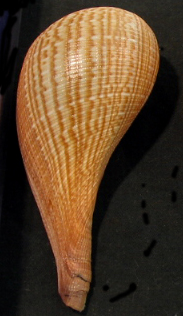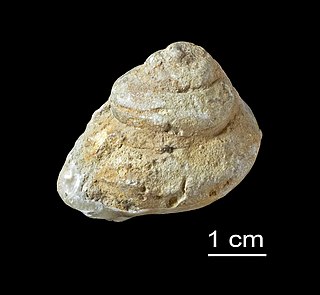
Heterobranchia, the heterobranchs, is a taxonomic clade of snails and slugs, which includes marine, aquatic, and terrestrial gastropod molluscs.
Strepsodiscus is an extinct genus of very primitive fossil snail-like molluscs from the early part of the Late Cambrian of North America. The coiled, slightly asymmetrical shells are about 3 cm in height. It is not known whether these are shells of gastropods or monoplacophorans, which are more primitive mollusks.
Poleumita is an extinct genus of medium-sized sea snails, fossil marine gastropods in the family Euomphalidae. This genus is known from the Silurian period.
Cyrtoneritimorpha, also Cyrtoneritida, is a clade of fossil sea snails, marine gastropod mollusks within the clade Neritimorpha.

Ficidae, common name the fig shells are a family of medium to large marine gastropods. It is the only family in the superfamily Ficoidea.

Clavilithes is an extinct genus of fossil sea snails, marine gastropod mollusks in the family Fasciolariidae, the tulip snails and spindle snails.
The Tripartellidae are an extinct family of fossil sea snails, marine gastropod molluscs in the clade Littorinimorpha.
Trypanaxidae is an extinct family of fossil sea snails, marine gastropod molluscs in the superfamily Campaniloidea.
Gordenellidae is an extinct taxonomic family of sea snails, marine gastropod mollusks in the informal group Lower Heterobranchia.
Trajanellidae is an extinct family of fossil sea snails, marine gastropod molluscs in the clade Caenogastropoda.

Pseudozygopleuridae is an extinct family of fossil sea snails, marine gastropod molluscs in the clade Caenogastropoda.
Isospiridae is an extinct family of fossil sea snails, Paleozoic gastropod mollusks.
Planitrochidae is an extinct family of fossil sea snails, Paleozoic gastropod mollusks.
Oriostomatidae is an extinct taxonomic family of fossil sea snails, marine gastropod mollusks in the clade Neritimorpha.
Tubinidae is an extinct taxonomic family of fossil sea snails, marine, gastropod molluscs in the clade Neritimorpha, the nerites and their allies.
Vltaviellidae is an extinct taxonomic family of fossil sea snails, marine, gastropod molluscs in the clade Cyrtoneritimorpha. There are two subfamilies, the Vltaviellinae and the Krameriellinae.
This overview lists proposed changes in the taxonomy of gastropods at the family level and above since 2005, when the taxonomy of the Gastropoda by Bouchet & Rocroi (2005) was published. In other words, these are recent updates in the way various groups of snails and slugs are classified.

Persististrombus is a genus of sea snails, marine gastropod mollusks in the family Strombidae, the true conchs.

Holopea is an extinct genus of fossil sea snails, Paleozoic gastropod mollusks in the family Holopeidae.
Phragmolites is an extinct genus of molluscs in the family Bucaniidae, paleozoic molluscs of uncertain position possibly being either Gastropods or Monoplacophorans in the superfamily Bellerophontoidea.





